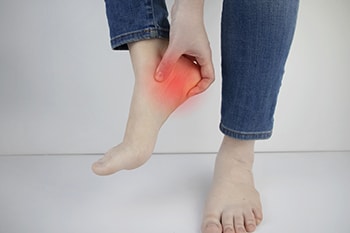By Andrew Siyabalawatte, Oct 2022.

Tendinopathy of the Achilles, Achilles Tendonitis and Achilles Tendinopathy, is a common lower extremity injury in everyday walkers, casual runners and athletes, especially distance runners. This lower leg condition, is usually due to accumulative stress through the tendon over time. It can also originate from sustained trauma like a muscle tear to the gastrocnemius (calf muscle). Achilles Tendinopathy is the second most common running-related musculoskeletal injury, following medial tibial stress syndrome, with an incidence of 9.1% to 10.9%.
A List of Causative Factors Leading to Achilles Injury

The most common factors include training errors, running technique, previous injury, footwear and running surfaces. Intrinsic factors related to the injury include tendon vascularity, gastrocnemius–soleus dysfunction, age, gender, body weight, genetic factors, muscle weakness
and lower limb misalignment and flat footedness (pronated feet).
A Real Pain in the Achilles and it’s Associated Symptoms

- Heel Pain – this may be an ache or a sharp pain, which feels worse when you’ve been active or put pressure on it.
- Stiffness in the Achilles Tendon – like Plantar Fasciitis also known as Policeman’s heel, the stiffness is often worse first thing in the morning or if you’ve been resting for a while
- Swelling at the back of your ankle – due to the repetitive stress on the Achilles Tendon insertion site of the heel.
- Tenderness when touching the tendon often indicates inflammation following activity, as it tries to heal and return to its normal state.
When To Rest the Achilles Tendon
There is never really a specific amount of time to rest the Achilles. It just is not the real solution. The real focus should be, how to stop overloading it.
If you rest it, it will start to lose some of its strength and fitness over time. This means that you can actually weaken your tendon further if you rest your Achilles tendon completely and try to avoid using it most of the time.
Short periods of complete rest may be appropriate if the Achilles tendon is extremely sore or painful, but this should not last more than a couple of days.
When To Strengthen the Achilles Tendon

When it comes to strengthening the lower limb, people often overlook the calf muscles. Over time, strengthening these muscles will also make the Achilles tendon stronger.
After a successful stretching regime, strengthening should often be introduced.
Stretching the Achilles tendon has been shown to increase collagen production and muscle fiber composition.
Stretching should be avoided during early stages of Achilles tendon rupture, however in the case of Achilles tendinopathy, stretching is encouraged. The goal of stretching is to prevent problems due to adhesions, shortening, or improper healing in the tendon.
The best type of strengthening in the initial stages of Achilles tendinopathy in my opinion, is isometric strengthening. Isometric strengthening involves holding the muscle under a sustained tension with minimal movement. An example of this type of strengthening exercise is the calf raise hold.

You can also perform this calf raise hold exercise while seated. Holding a light weight to begin with, aim for a 1 min hold, slowly returning in a controlled manner to the start position. Aim to gradually increase the hold time to 5 mins if possible.
Closing Comments
The stronger the calf muscle, the less stress the tendon will experience. This in turn, will allow the tendon to manage the stress it is subject to when walking or running. The real key however to managing and preventing Achilles tendinopathy, it to pay close attention to avoid overloading the Achilles. Knowing when to rest and when to incorporate stretching and strengthening exercises depends on how well you understand your body. It is all about balance.

If you need any assistance or guidance with managing your Achilles pain, do not hesitate to book with me or my team. You will find us at our Guildford and Thames Ditton clinics most days of the week!
Happy walking and running.

